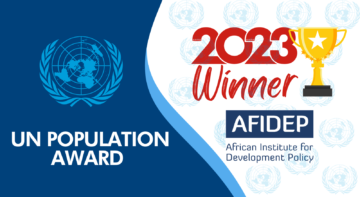Blogs

Family planning is one of the most successful development interventions, with wide-ranging benefits to the health of mothers and children, empowerment of women, economic growth and environmental preservation. According to ‘Adding It Up’, a 2014 report by the Guttmacher Institute and UNFPA, globally, if all women who want to avoid pregnancy used modern contraceptives; unintended pregnancies would drop by 70 percent, from 74 million to 22 million per year; maternal deaths would drop by 67 percent, from 290,000 to 96,000; and newborn deaths would drop by 77 percent, from 2.9 million to 660,000s. Kenya recognises the benefits of using effective family planning methods, which is identified as key in facilitating rapid fertility decline, the first step in harnessing the demographic dividend. Consequently, the country has set very ambitious targets for contraceptive use. The Population Policy for National Development (PPND) developed in 2012, aspires to increase the national use of modern contraceptives to 58 percent by 2020 and 64 percent by 2025. According to the Kenya Demographic and Health Survey 2014 report, Kenya’s contraceptive rate was 58 percent in 2014, putting the nation on track to surpass its 2020 target.
ImpactNOW Model
The DemDiv Model results, a research tool that projects the potential demographic dividend that a country can earn, showed that increasing contraceptive use would reduce the average fertility rate to 2.9 births per woman, thus opening the window of opportunity to earn the demographic dividend. In addition, Kenya could earn an additional USD 2,500 income per person if it invested in family planning in addition to maximum economic investments and provision of quality education to its population. As a follow-up to the DemDiv results, on 12th May 2015, the National Council for Population and Development (NCPD), launched the results of the ImpactNOW Model, a tool that quantifies the health and economic benefits of investing in family planning. The forum was attended by various development experts drawn from government agencies, non-governmental, and civil society organisations. The model results, developed by NCPD in partnership with the USAID-funded Health Policy Project (HPP), were officially launched by Hon Dr Rachael Nyamai (MP and Chairperson of the Kenya Parliamentary Health Committee) at the Hilton Hotel in Nairobi.
Family planning saves lives
As the benefits of family planning become more apparent, even religious leaders have come forth to advise the masses. Earlier in 2015, Pope Francis created quite a buzz after he said that Catholics should not feel they have to breed “like rabbits” because of the Church’s ban on contraception. He mentioned a woman he recently met who already had seven children by cesarean sections and put her life at risk by becoming pregnant again. He said he chided her for “tempting God” and added: “That was irresponsible.”
Time and again, we have also witnessed heart-wrenching stories in our local media of mothers losing their lives and those of their newborns while giving birth due to complications, and young girls losing their lives, or ability to ever conceive again, due to unsafe abortions. Increasing contraceptive use to 64 percent by 2020 would prevent 7.75 million unintended pregnancies, avert 1.4 million unsafe abortions and 20,670 maternal deaths, and save the lives of 144,175 children. The ImpactNOW Model results underscore the need for investments in family planning in order to save the lives of mothers and children. The fewer children a woman has, the healthier she is as she is able to avoid high-risk pregnancies, avoid unintended pregnancies which may result in seeking unsafe abortions, medical complications and interrupted schooling. Children born to a mother who has spaced the births and with fewer children are also better taken care of and more likely to live beyond their fifth birthday.
Family planning saves money
Family planning investments by governments are not misplaced. For every Kshs 85 (USD 1) the Kenyan government spends on family planning, the country will save Kshs 381 (USD 4.48) in direct healthcare costs. If county governments accelerate the uptake of modern family planning methods these savings will increase to Kshs 464 (USD 5.46) per Kshs 85 (USD 1) spent on family planning. Kenya will also save an additional Kshs 6.8 billion (USD 180 million) in direct healthcare costs associated with unintended pregnancies by 2020 if county governments maximise investments in family planning. Expanding the range of choice of family planning methods to include implants and IUCDs will lower family planning costs over time, saving the counties even more money.
Family planning programme funding
Although Kenya started budgetary allocations for the procurement of family planning commodities in 2005, the devolution of the healthcare sector has watered down the achievements gained in the last decade or so. This is because until recently, no county government had allocated any funds for FP commodity procurement. Even so, a lot of advocacy efforts are needed at the county level to increase budgetary allocations for the family planning programme so as to avoid stock-outs of family planning commodities’. These model results will go a long way in showing the benefits, both health-wise and economically, of investing in family planning. With the ball set rolling, it is now time for the county governments to roll up their sleeves and get to work to make the goals of the PPND 2012 a reality, and Hon. Nyamai emphasised this further in her keynote address.
“The question we’re asking ourselves as the Parliamentary Health Committee is whether our counties are ready to take up this challenge. Do we leaders, knowing very well that we are politicians, do we also believe in family planning? We would like to push this agenda so seriously. [Therefore], the statements that we have been hearing from, sorry to say [this], our governors, that we need more people for the purpose of voting many years to come, these are issues that need to be discussed, and people need to be told the truth about family planning.”
According to the discussions, county governments must prioritise investments in voluntary and high-quality family planning. Specifically, they should:
- Establish family-planning specific budget lines within the county programme-based budgets and allocate the funds appropriately
- Allocate and spend funds on family-planning related supplies and personnel in recurrent budgets
- Adapt and implement national policies at the county level, including the Community Health Strategy
- Scale-up training and counseling of family planning service providers on the provision of implants and intra-uterine contraceptive devices (IUCDs)
- Ensure multisectoral involvement in the provision of youth-friendly family planning services
- Track spending on family planning commodities, in-service training, and facility improvement based on budget allocations
Next steps
On the next steps, Hon. Nyamai pointed, “I urge NCPD and partners to disseminate the model to all counties. It is my hope that the partners involved in this [initiative] will engage the counties so as to build their capacity, to enable their data to the model, and interpret the results. This will enhance advocacy efforts and decisions at the county level, given that the model demonstrates the near term benefits of investing in family planning.”
“As a health committee in the National Assembly, we endeavor to work together with the counties and all stakeholders including the team that sits here today, in the health sector, in a bid to achieve quality healthcare for all Kenyans as it is provided for in the constitution. We, therefore, welcome your support to make this a reality, and not a dream for the Kenyan people, and more so the women and children of this country”, she concluded.
This article is based on findings derived from the Policy Brief ‘Family planning in Kenya: Saving lives, saving money’ by NCPD and HPP (2015).
Related Posts





